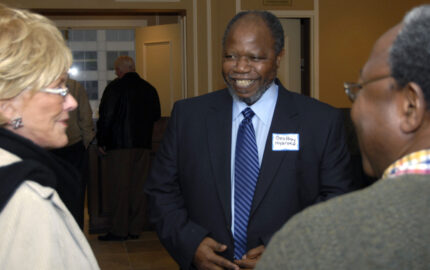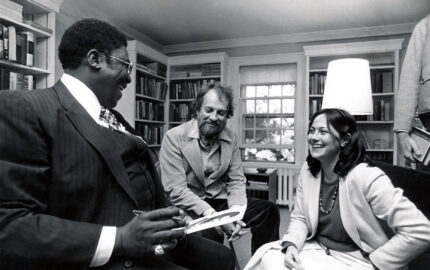I first heard the word convergence when it was proposed that I teach digital journalism to this year’s class of Nieman Fellows. Evidently, its one of those words that defines something that a lot of people are already doing but haven’t named. I “went digital” about three years ago while I was working on a series of short documentaries in Africa. I used digital technology because its affordability made it a cost-effective way to work. And the small size of the equipment made it less invasive and thus helped me to more easily connect with those whose lives I was profiling. The camera is so unobtrusive that people forget it’s even there.
Currently, I am editing a film I directed that involves young men confessing to acts of ethnic cleansing in the African nation of Burundi. In this documentary experience, the digital advantages are clear. A traditional video (beta) camera costs exponentially more, would have made moving around difficult and, more important from a journalistic perspective, would have drawn undesired attention not only to us but to our sources. After six weeks of filming in the midst of that country’s civil war, we were able to put all of our recorded cassettes and the camera in a single carry-on bag. And here’s where convergence comes in: One month later, the story of these confessions was published on the front page of The Washington Post.
Five years ago, an independent journalist would not have been able to do this kind of multimedia reporting. This leads one to wonder how many other stories like this one are waiting to be told, but due to cutbacks in foreign reporting, especially by network news, will never be told unless journalists start to reinvent themselves as information entrepreneurs.
Right now, the best example of the digital medium’s greatest impact can be found in the music industry. Musicians and bands used to have to wait for big-money record labels to record, package and promote their work. There was a good chance they’d be ripped off along the way. With digital recording, there are now thousands of labels and independently produced CD’s that find niche markets. An entirely new economy has emerged to support these artists. Combined with increased bandwidth, the direct sale and transfer of this independently produced music cuts the traditional music industry out of the picture. As a model for independent journalists/entrepreneurs, think something like a subscriber-based Napster.
If journalists were to operate in this way—merging passion with careful deployment of technology—then news and information will find its market. Out of this could emerge a real change in the culture of news in similar ways to how this shift occurred in music. But before we can talk about a revolution in independent journalism based around this new technology, we need to remember that the cost of gathering and distributing information has steadily declined for decades without a corresponding improvement in the quality of news reporting. In fact, the coverage of news—like the story I did in Burundi—seems to be disappearing at a rate that is in direct proportion to technical advances.
If changes in the music industry are worth emulating, then the food industry offers a chilling reminder of approaches to be avoided. New technology in agriculture could have improved health and eradicated hunger decades ago. Instead, hunger seems as prevalent worldwide as it ever did and, in this country, our mass-produced and nutrition-deprived food can actually harm those who consume it. Technologic advances in the food industry have solved neither the problem of malnutrition nor hunger. In fact, the quest for profit puts new chemicals and artificial ingredients into our bodies, resulting in a whole new set of health concerns, from obesity to heart disease to cancer.
Similarly, new technology that could have enhanced foreign reporting and increased the number of important and illuminating news reports has failed to do so for a variety of reasons. One reason involves another kind of convergence, this one financial. The lack of investment and commitment by major networks has left serious TV journalists and viewers without a way to connect. Unfortunately, this circumstance has also flowed into print and radio as cross- and conglomerate-ownership of various media creates further confusion in the relationship between journalists and their communities.
It is precisely to try to relieve this confusion that I wanted to work with mid-career journalists at the Nieman Foundation this spring. We talked about how and why new technology will enable them to stay alive in the fast changing news business. I urged them to think about how the future of real reporting will be concentrated not in the hands of network news executives but in the hard drives of independent journalists who find the means to produce and market their information directly to readers or viewers. It might take time for these channels to develop, but they will.
It is conceivable—and hopeful—that someone at the corporate headquarters of Disney or GE will decide that provocative, hard hitting journalism is at least as marketable as cartoons or weapons systems. Until then, journalists should stop bemoaning the anorexic news budgets and use this new technology to move forward on their own.
Bryan Rich, a 1998 Nieman Fellow, is teaching a course on digital technology at the Nieman Foundation. His documentary about atrocities in Burundi, “Breaking the Codes,” based around on-camera confessions of genocide in Burundi, is in post-production. See www.breakingthecodes.com.
Currently, I am editing a film I directed that involves young men confessing to acts of ethnic cleansing in the African nation of Burundi. In this documentary experience, the digital advantages are clear. A traditional video (beta) camera costs exponentially more, would have made moving around difficult and, more important from a journalistic perspective, would have drawn undesired attention not only to us but to our sources. After six weeks of filming in the midst of that country’s civil war, we were able to put all of our recorded cassettes and the camera in a single carry-on bag. And here’s where convergence comes in: One month later, the story of these confessions was published on the front page of The Washington Post.
Five years ago, an independent journalist would not have been able to do this kind of multimedia reporting. This leads one to wonder how many other stories like this one are waiting to be told, but due to cutbacks in foreign reporting, especially by network news, will never be told unless journalists start to reinvent themselves as information entrepreneurs.
Right now, the best example of the digital medium’s greatest impact can be found in the music industry. Musicians and bands used to have to wait for big-money record labels to record, package and promote their work. There was a good chance they’d be ripped off along the way. With digital recording, there are now thousands of labels and independently produced CD’s that find niche markets. An entirely new economy has emerged to support these artists. Combined with increased bandwidth, the direct sale and transfer of this independently produced music cuts the traditional music industry out of the picture. As a model for independent journalists/entrepreneurs, think something like a subscriber-based Napster.
If journalists were to operate in this way—merging passion with careful deployment of technology—then news and information will find its market. Out of this could emerge a real change in the culture of news in similar ways to how this shift occurred in music. But before we can talk about a revolution in independent journalism based around this new technology, we need to remember that the cost of gathering and distributing information has steadily declined for decades without a corresponding improvement in the quality of news reporting. In fact, the coverage of news—like the story I did in Burundi—seems to be disappearing at a rate that is in direct proportion to technical advances.
If changes in the music industry are worth emulating, then the food industry offers a chilling reminder of approaches to be avoided. New technology in agriculture could have improved health and eradicated hunger decades ago. Instead, hunger seems as prevalent worldwide as it ever did and, in this country, our mass-produced and nutrition-deprived food can actually harm those who consume it. Technologic advances in the food industry have solved neither the problem of malnutrition nor hunger. In fact, the quest for profit puts new chemicals and artificial ingredients into our bodies, resulting in a whole new set of health concerns, from obesity to heart disease to cancer.
Similarly, new technology that could have enhanced foreign reporting and increased the number of important and illuminating news reports has failed to do so for a variety of reasons. One reason involves another kind of convergence, this one financial. The lack of investment and commitment by major networks has left serious TV journalists and viewers without a way to connect. Unfortunately, this circumstance has also flowed into print and radio as cross- and conglomerate-ownership of various media creates further confusion in the relationship between journalists and their communities.
It is precisely to try to relieve this confusion that I wanted to work with mid-career journalists at the Nieman Foundation this spring. We talked about how and why new technology will enable them to stay alive in the fast changing news business. I urged them to think about how the future of real reporting will be concentrated not in the hands of network news executives but in the hard drives of independent journalists who find the means to produce and market their information directly to readers or viewers. It might take time for these channels to develop, but they will.
It is conceivable—and hopeful—that someone at the corporate headquarters of Disney or GE will decide that provocative, hard hitting journalism is at least as marketable as cartoons or weapons systems. Until then, journalists should stop bemoaning the anorexic news budgets and use this new technology to move forward on their own.
Bryan Rich, a 1998 Nieman Fellow, is teaching a course on digital technology at the Nieman Foundation. His documentary about atrocities in Burundi, “Breaking the Codes,” based around on-camera confessions of genocide in Burundi, is in post-production. See www.breakingthecodes.com.



